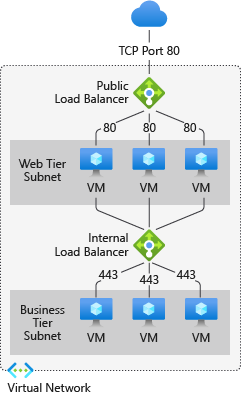What is a Microsoft Azure Load Balancer?
Load balancing refers to evenly distributing load (incoming network traffic) across a group of backend resources or servers.
Azure Load Balancer operates at layer 4 of the Open Systems Interconnection (OSI) model. It's the single point of contact for clients. Load balancer distributes inbound flows that arrive at the load balancer's front end to backend pool instances. These flows are according to configured load-balancing rules and health probes. The backend pool instances can be Azure Virtual Machines or instances in a virtual machine scale set.
A public load balancer can provide outbound connections for virtual machines (VMs) inside your virtual network. These connections are accomplished by translating their private IP addresses to public IP addresses. Public Load Balancers are used to load balance internet traffic to your VMs.
An internal (or private) load balancer is used where private IPs are needed at the frontend only. Internal load balancers are used to load balance traffic inside a virtual network. A load balancer frontend can be accessed from an on-premises network in a hybrid scenario.

Figure 1 : Balancing multi-tier applications by using both public and internal load balancer
Why monitor Microsoft Azure Load Balancers?
Microsoft Azure Load Balancer provides load balancing for applications ensuring high availability and robust performance. It scales automatically with increasing application traffic providing a better customer experience. Load Balancer also improves application uptime by probing the health of application instances, automatically taking unhealthy instances out of rotation, and reinstating them when they become healthy again. For obtaining focused metrics on health status and overall service performance, which will help all the stakeholders take effective performance/scaling/costing decisions, Microsoft Azure Load Balancers should be monitored.
